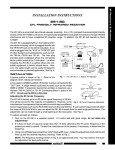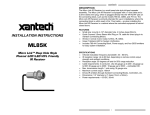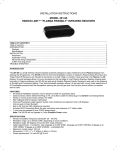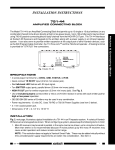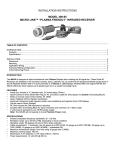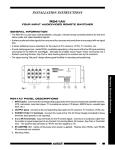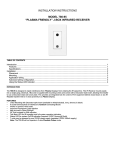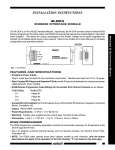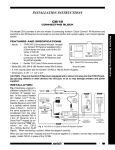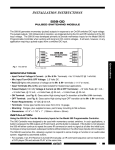Download Xantech 490-85 Radio User Manual
Transcript
INSTALLATION INSTRUCTIONS 490-85 CLF / LCD Friendly Micro Link IR Receiver DESCRIPTION The 490-85 is a CFL (compact fluorescent light) / LCD (liquid crystal display) version of the 490 Micro Link series IR receivers. It is specifically designed to have greater immunity to high frequency ballasted CFL and overhead fluorescent type infrared inference and to have exceptional IR reception range. These small IR receivers have been designed primarily for mounting in panels, doors, cabinets, etc. for control of A/V equipment behind closed doors. They may be mounted in walls, ceilings, wall speakers, etc. - anywhere an inconspicuous appearance is desired. Their high sensitivity allows placement behind speaker grilles and still receiver IR commands up to 20 feet away. FEATURES AND SPECIFICATIONS IR carrier frequency reception bandwidth: 30 to 60 kHz. IR carrier adjustment: 32 to 56 kHz (allows output carrier frequency to be matched to a controlled component for optimum performance). IR reception range: > 50 feet Dimensions: 2.75” Length x 0.75” DIA. Bezel is 0.90” DIA. Works in normal 3-wire mode (12VDC, IR, GND). Red talkback LED for system verification. RF Grid included for EMI interference reduction. Includes 3-Terminal Block for easy extension of 7 foot ribbon cable. 7 units may be powered by one 781RG power supply. Normal Operating Power: +12VDC, 20mA. Note: The 490-85 will not operate in 2-wire Phantom Power mode. INSTALLATION This unit is meant to be interfaced to Xantech Connecting Blocks, such as CB12, 789-44, 791-44, etc. MOUNTING 1. Drill a 3/4” hole in any flat surface, such as a cabinet panel. Pass the cable and body of the 490-85 through the hole and secure from the rear with the nut (supplied). 08905105A -1- IR CARRIER ADJUSTMENT The 490-85 is factory set to an IR carrier repeat frequency of 39kHz. This will be correct for the majority of installations. However, some manufacturer’s components that you wish to control may use different carrier frequencies (such as RCA DSS satellite receivers that use 56kHz). If sure carrier frequencies fall within the range of 32kHz to 56kHz, you can adjust the 490-85 to match them for the best range performance. The adjustment can be made through the small opening on the rear. To adjust, proceed as follows: 1. First, try the 490-85 in a repeater system. If it works well with good range, do not make any adjustments! 2. If it does not work or has poor range (less than 15 feet), determine the IR carrier frequency of the product you wish to control. Contact the manufacturer of the product, if necessary, to determine this frequency. 3. Using a small blade type screwdriver, rotate the adjustment shaft until the slot lines up with the desired frequency. 4. If you have products in the same IR system that have different IR carrier frequencies, you will have to adjust the 490-85 to a midway position. For example, some may operate at 38kHz and others at 56kHz. In this case, set the adjustment to approximately 47kHz, a midway position. Note: Some products are more tolerant of compromised frequency settings that others. You may have to “fine tune” the adjustment to “favor” the least tolerant component for the best performance of all units in the system. Clock-wise (CW) Counter Clock-wise (CCW) Increase carrier frequency Decrease carrier frequency 490-85 CABLE CONNECTIONS The 490-85 may also be used where the 7-foot lead is not long enough. In this case, simply cut off the mini plug, strip the leads and connect them to a 3-terminal block. For correct color identification of wires, refer to the following tables and diagrams: PLUG RING TIP SLEEVE CABLE LEADS BLACK WHITE RED DESCRIPTION GROUND IR OUTPUT +12V 490-85 Ring Tip WHITE 3-Conductor Wire to Controlled Equipment OUT +12V Sleeve Insulators Mini Plug (3-Conductor) 08905105A See Tables for Wire Color GND 7-Foot 3-Conductor Cable with Mini Plug removed 3-Terminal Block -2- APPLICATION WIRING A typical system, with a 490-85, 781RG Power Supply and 283M Emitters plugged into a 791-44 Connecting Block, is shown in the figure below. 1. Plug the 3.5 mm stereo mini plug from the 490-85 into the 791-44 connecting block labeled “IR RCVR”. 2. Plug in the 3.5 mm mono mini plug from any of the 282, 284, 283 and 286 series Emitters into the jacks labeled EMITTERS on the 791-44 Connecting Block and affix the opposite end of the IR Sensor Window of the controlled equipment. 3. Plug in the 2.1mm Coaxial power plug of the 781RG Power Supply (not included) into the jack labeled 12VDC on the 791-44 Connecting Block. 4. Plug the AC end of the 781RG Power Supply into an ‘un-switched’ 120VAC outlet. 490-85 Series IR Receivers 0.469" +12 VDC GND S TAT U S IR IN MODEL 791-44 AMPLIFIED CONNECTING BLOCK 12 VDC 08905105A 120 V AC (Unswitched) XANTECH CORPORATION. SYLMAR CA MADE IN U.S.A. 781RG Controlled Equipment (mounted behind closed cabinet doors) 283M Emitter AV Receiver EMITTERS 7 Foot 3-Conductor Cable with Quick Connect Mini Plug Power Supply Hand Held Remote Cable Box RCVR 490-85 (mounted on or near cabinet in an inconspicuous location). Satellite Receiver 283M Emitter HI IR OUT 1 7/8" 791-44 Amplified Connecting Block 283M Emitter CD Changer 283M Emitter Cassette DecK 283M Emitter -3- IR Troubleshooting Guide NOTE: Due to the many variables in a given installation, the troubleshooting countermeasures you will have to take may vary from job to job. Each installation is different due to the number of IR receivers in use, length of wire runs, type of wire, amount of ambient IR noise present, etc…. Therefore, your countermeasures for a particular job will range from nothing at all, to any combination of the solutions listed below. Model #’s IR Receivers: Model #’s 291, 480, 490, & 780 Series Symptom #1: DIM or NO Talk Back LED during IR Reception or reduced operational range Cause: Solution 1. Weak Batteries in Transmitting Remote. Replace batteries. 2. Bad Emitter or no emitter plugged into Test emitter and verify wiring. connecting block. 3. Signal wire between IR Receiver and the Recheck wiring. 4. Power Supply not putting out proper voltage. Verify supply is a 12VDC regulated supply reading between 11.5 to 13VDC under load. Should be using Power Supply Model 781RG (12VDC Regulated, 200mA) or 78200 (12VDC Regulated, 1.2A) Connecting Block is open. If you are using a passive connecting block, such as a 789-44, and the system is not working, try the amplified connecting block, Output from the IR receiver/connecting block model 791-44. Put one of the small 5. is connected to a high impedance IR input jack plastic case jumpers supplied with on a component. the block on the pins next to the emitter jack. This will provide the IRin jack on the component with a hotter signal. 6. IR Receiver is inoperable. Replace Receiver. Need to use a Bypass Kit (model (XTRALINK Only) RF Amplifier is being used BYPASS94 Kit) to route the IR 7. on same COAX Line anywhere between the control signals around the Coupler (CPL94) and Injector (INJ94). amplifier(s). 08905105A -4- Symptom #2: TB LED on IR Receiver (and/or Emitters) Dimly lit or flickering Cause: Signal and ground wires are reversed or 1. shorted either at the connecting block or IR receiver. 2. Defective emitter. Relatively high levels of ambient noise. This 3. can be due to any of the following: Sunlight, florescent Lighting or Plasma Displays. Solution Recheck your wiring. Replace Emitter In this case use either a SUN filter (SUN480, SUN490, SUN780), or any of our ‘CFL Friendly’ IR Receivers (291-80, 480-80, 780-80). For Plasma Interference use the 490-90 or 780-90 ‘Plasma Friendly’ IR Receivers. These can also be used in direct sunlight and in the presence of ‘tube style’ florescent lighting. Reposition IR Receiver and/or cabling away from emitting device. EMI induced noise. This can be due to light You can also place a 470Ohm dimmer controls or other radiating electronic resistor in parallel with the IR Signal 4. devices (PC’s or any poorly shielded electronic and GND connections on the device). connecting block. This will also help alleviate any stray capacitance in the cable. 5. Plasma Interference 08905105A Use a 490-90 Plasma 'Friendly' IR Receiver. If already using a 490-90 unit, please note the Plasma interference can be reflected off of any item it comes into contact with within approx. 3ft. From the front of the display. Keeping this in mind, make sure that the 490-90 is free from any obstruction that might reflect back into the receiving eye. -5- Symptom #3: TB LED on IR Receiver (and/or Emitters) on solid Cause: 08905105A Solution Use a 490-90 Plasma 'Friendly' Receiver. If already using a 490-90 unit, please note the Plasma interference can be reflected off of any item it comes into contact with within approx. 3ft. From the front of the display. Keeping this in mind, make sure that the 490-90 is free from any obstruction that might reflect back into the receiving eye. 1. Plasma Interference 2. Voltage and Ground wires are reversed at Recheck your wiring. the connecting block or IR Receiver In this case use either a SUN filter (SUN480, SUN490, SUN780), or any of our ‘CFL Friendly’ IR Receivers (291-80, 480-80, 780-80). For Plasma Interference use the 490-90 or 780-90 ‘Plasma Friendly’ IR Receivers. These can also be used in direct sunlight and in the presence of ‘tube style’ florescent lighting. 3. Relatively high levels of ambient noise. This can be due to any of the following: Sunlight, florescent Lighting or Plasma Displays. 4. Reposition IR Receiver and/or cabling away from emitting device. You can also EMI induced noise. This can be due to light place a 470Ohm resistor in parallel with dimmer controls or other radiating electronic the IR Signal and GND connections on devices (PC’s or any poorly shielded the connecting block. This will also help electronic device). alleviate any stray capacitance in the cable. 5. Verify supply is a 12VDC regulated Power Supply not putting out proper voltage. supply reading between 11.5 to 13VDC under load. -6- Symptom #4: TB LED on IR Rec. blinks but 283M or 286M 'Blink' style Emitters do not Cause: 1. 2. 3 Solution There may be a short, such as a staple Recheck your wiring. driven through the Signal and GND wires of the IR Receiver and/or the emitter. Replace Emitter or use TEST EMITTER Emitter may be shorted internally to check circuit. (XTRALINK Only) TV on same splitter with Place a DC Blocker (Model 203-00) on no IR Receiver installed any TV Leg without IR Receiver Symptom #5: Intermittent IR control (I.e. buttons on remote need to be pressed multiple times) Cause: Plasma Interference Solution Use a 490-90 Plasma 'Friendly' Receiver 2. Relatively high levels of ambient noise. This can be due to any of the following: Sunlight, florescent Lighting or Plasma Displays. In this case use either a SUN filter (SUN480, SUN490, SUN780), or any of our ‘CFL Friendly’ IR Receivers (291-80, 480-80, 780-80). For Plasma Interference use the 490-90 or 780-90 ‘Plasma Friendly’ IR Receivers. These can also be used in direct sunlight and in the presence of ‘tube style’ florescent lighting. 3. Putting a 470-ohm resistor in parallel at the connecting block between signal and ground will effectively discharge the capacitance of the wire. This will allow the signal to travel farther on shielded wire. Adding a resistor between the input and ground of the connecting block Long Wire Runs – shielded wire typically of will drop the IR level down somewhat. 100 feet (30 meters) or longer causes a filter Passive connecting blocks, such as the effect due to accumulated capacitance of the 789-44, may not have enough signal wire. Intermittent, or no IR control, could output for consistent control of the actually be because of the longer wire runs. equipment. You may have to upgrade to an amplified connecting block to bring the IR level back to normal. In these cases, the 791-44 would be an ideal connecting block for single zone systems while the 795-20 would work best for a 2-4 zone system. 1. 08905105A -7- Symptom 6: Emitters function but some (or all) components do not respond. 1. 2. 3. 08905105A Cause: Solution Emitter placement is incorrect. Reposition the Emitter so that it is directly over the components sensor window. Consult the components owners manual of the unit for the exact location of the IR Sensor Window. Reposition the Emitter to a position that is suitable for the unit. Use a 283 or 286M Blink style emitter (they have a lower output than non-blink emitters 282 and 284M). If the components do not Emitter placement is correct but the signal is need to be controlled directly without an IR Repeater system (components are overpowering the unit or there is bleedlocated in an equipment closet), place a through from other emitters close by. Mouse Emitter Shield cover over the Emitter (PN#MS1). The rounded (nonstick) side of the emitter is a hi-output side and can reflect off other devices and overpower some components IR Sensors. If using a CB12 connecting block, try a 789-44 connecting block. This has a series resistor at the output, which will limit current to the Emitter. Using a CFL-Friendly IR Receiver (291-80, 480-80, or 780-80) and trying to control a unit with a carrier frequency greater then 40kHz (I.e. RCA DSS, Scientific Atlanta, Jerald, and General Instruments Cable or DSS Set Top Boxes). If you are using the 291-80 or 780-80 CFL Friendly receiver, locate the Carrier Frequency Adjustment on the unit and using a small blade screwdriver, (3/32" blade width max.) rotate the adjustment for best performance of all the units in the system. Note: The 480-80 version does not have this feature; you will either need to change the unit to a 291-80, 780-80 or the 490-90. The 490-90 is a wide band unit and will not require any frequency adjustment. -8- Symptom #7: Absolutely No Functionality (How to determine which component is at fault) Step: Component to Test Instructions 1. Verify Power Supply With a Multimeter, measure the DC Voltage of the supply while it is connected to the Connecting Block. Put the Negative lead of the meter on the terminal marked GND and the Positive Lead on the terminal marked 12VDC (or V). You should get a reading between 11.5VDC and 13.0VDC. If not, remove the supply from the Connecting block and measure again this time directly on the 2.5mm Coaxial plug. If it reads between 11.5VDC and 13VDC, power supply is most likely good. Reconnect to the Connecting Block and proceed to step 2. NOTE: In most cases this will indicate the supply is good but in some cases the supply can still be bad (i.e. reads good when not plugged in but may not be able to handle the current load of the system.) 2. Remove the power supply from the connecting block and all Emitters from the output. Place a jumper wire on the Verify Emitter. (283M or 286M Blink connecting block between IR and +12v. Style ONLY) Reconnect the Power Supply and one emitter. The Emitter should Light bright and solid. Repeat for all emitters. 3. Use a diode tester to verify proper Emitter operation. Remove Emitter from Connecting Block. Place the Positive Lead of the tester on the TIP of the Verify Emitter. (282M or 284M NON Mono Mini Plug and the Negative Lead on the Shield of the Mono Mini Plug. Blink Style) Meter should read a voltage. When the leads are reversed (Positive lead on Shield and Negative lead on TIP) you should not get any voltage reading at all. 08905105A -9- 4. Verify IR Receiver. Remove the power supply from the connecting block and all Emitters from the output. Place a jumper wire on the connecting block between IR Signal and GND. Reconnect the Power Supply. With a known good hand-held remote, shoot a constant IR Command at the receiver and verify the TB LED on the Receiver lights. Xantech Corporation 13100 Telfair Avenue, 2/F Sylmar, CA 91342 Phone: (818) 362-0353, Fax: (818) 362-9506 Instructions, 490-85 © 2007 Xantech Corporation This document is copyright protected. No part of this manual may be copied or reproduced in any form without prior written consent from Xantech Corporation. Xantech Corporation shall not be liable for operational, technical, or editorial errors/omissions made in this document. 08905105A - 10 -











